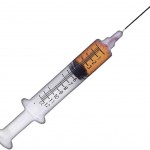
Fear and anxiety about medical procedures can be a barrier to accessing healthcare for people with learning disabilities. In particular, fear of needles can mean that blood tests may not be able to be taken and this can prove a significant clinical challenge.
The researchers in this case study used a changing criterion design, they could an approach which recognises that not all behaviours need instant responses, but that some can be changed gradually over time. They wanted to look at a graduated exposure treatment for blood-injury-injection phobia. They were working with a man with autism and learning disability who had a history of not complying with medical interventions,
They also used differential reinforcement which aims to increase the frequency of a desirable behaviour whilst eventually eliminating the undesirable behaviour, and a safety signal was also evaluated during treatment.
What they found was that they were able to help the man to comply with needle-to-skin contact by the time they reached the final criterion phase. He was also able to maintain thia behaviour at follow-up.
They found that the differential reinforcement and safety signal added to the quality of treatment but also that it was possible to successfully fade these as the man’s treatment progressed.
They conclude that this exposure approach was effective in reducing the man’s phobic behaviour and that the approach may be flexible enough to accommodate changes to its components in order to be applicable to real-world settings.
An Evaluation of Multi-Component Exposure Treatment of Needle Phobia in an Adult with Autism and Intellectual Disability, Wolff J & Symons F in Journal of Applied Research in Intellectual Disabilities, 26: 344–348
